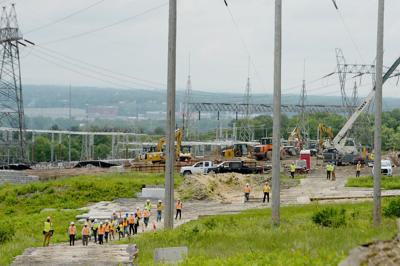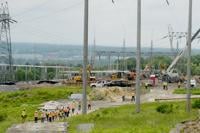ROTTERDAM — It’s probably the last thing you’ll think of when you reach in the fridge for something cold to drink, but the network of power lines that carried the electricity to your refrigerator is every bit as complex as the network of roads a truck driver used to deliver the milk, beer and juice that’s in the refrigerator.
And just like the road network, the power grid is a little congested in parts of New York.
Electricity transmission contractors, managers and planners gathered off Gordon Road in Rotterdam on Wednesday morning to mark the re-energizing of the first rebuilt portion of a power line running 93 miles from the Utica area to the Albany area.
It is at once a significant milestone and something that will be invisible to the public, because as long as the fridge is cold and the lights are on, people tend not to think about such details.
The $600 million upgrade of the line from Marcy to New Scotland is one of the first steps being taken to prepare the grid for the green power revolution New York leaders plan to undertake. New York Power Authority and LS Power Grid New York are joint developers on the project.
Under this vision, the state will see an increase in demand for electricity as consumers are steered away from fossil fuels and it will simultaneously see a decrease in the predictability of the supply of this electricity — wind and solar power are highly variable.
Long-distance power lines are important because two-thirds of New York’s electricity is generated upstate but two-thirds of the demand is downstate.
One of the main bottlenecks in this flow of current from northern and western New York to southern New York is what’s called the Central East Energy Connect from Marcy to Utica. It is receiving new poles and lines that will boost its capacity 500% through use of thicker wire that can carry 345,000 volts rather than 230,000 volts and roughly quadruple as many amps.
The portion energized Wednesday is a five-mile stub off the main line, bringing electricity to a substation that steps the power down to 115,000 volts for local distribution. National Grid substations across the area step the voltage down further for use in the community; the transformers that dot neighborhoods perform the final step-down for residential and commercial use.
NYPA President and CEO Gil Quiniones said the goals of the project are improved reliability, greater capacity, better resilience to severe weather, and increased support for the carbon-free New York envisioned in the next few decades.
It’s the first major rebuild undertaken in New York state since the late 1980s, he said, and NYPA is now working on two other rebuilds for a total of 250 miles.
The project includes construction of new substations in Princetown, where the branch to Rotterdam splits off the main line, and in Rotterdam, where the branch ends. These also are technological upgrades at the substations, which will be equipped with gas insulators and will be enclosed instead of open-air.
The project has a peak workforce of 125 on the power line and 40 to 50 on the substation work.
An array of 60-year-old H-frame wooden supports reinforced with guy wires are being replaced with standalone steel towers erected by crane. The electrical wires are being strung on them via helicopter, which saves time and manpower.
SEA CHANGE
The work showcased Wednesday is in some ways the first major change to the power grid in generations, said Richard Dewey, president and CEO of the New York Independent System Operator, which manages the state’s power grid and plans for its future needs.
It’s also part of the fundamental revisioning of power generation, transmission and use in New York directed by Gov. Andrew Cuomo and the state Legislature.
“The energy system in New York is going through a remarkable change right now as we attempt to decarbonize the electric system,” Dewey said.
“Not much changed in the electric system in 80, 90 years. You’re going to see a remarkable sea change in terms of how power is transmitted, how power is generated and how power is consumed over the next 20 years.”
Unmentioned at Wednesday’s ceremony: Current technology cannot do all these things. Developing, buying and installing it will be extremely expensive. The state must sustain the political and popular will to invest tens of billions of dollars to make it all happen, while the state and national economies remain strong enough to make that possible.
And the existing system must remain in operation as all this is happening. That may be the easiest part, given the redundancy built into it.
Dewey spoke about the technology after the ceremony.
Generating electricity accounts for only 16% of New York’s carbon footprint, he said. But to address the major sources of carbon emissions — transportation and buildings — the state needs to be able to move more electricity around, not less.
“So it’s about getting that infrastructure in place,” Dewey said. “There’s only so much you can do with today’s wind, solar and batteries.
“Technology can help us — and we’re counting on it helping us in terms of longer-duration storage, better batteries that can go for longer, carbon-free dispatchable energy generation like green hydrogen, these are technology needs that are not here yet.”
It’s on the radar of NYISO and other agencies as they plan for the future.
Dewey describes a sort of three-dimensional chess game over the next two decades:
- Less electricity being used as devices and their users become more efficient;
- More electricity being used as vehicles and structures switch from carbon fuel to electricity;
- The supply of electricity becoming less predictable and less reliable as carbon-burning power plants that can be cranked up to meet demand give way to wind and sunlight that cannot be controlled;
- As yet unknown roadblocks or break-throughs in technology that may make the goals easier or harder to reach, or reachable on a different path.
On its most user-intensive day, New York’s peak demand for electricity is about 34,000 megawatts.
To put this in context, the NYPA’s hydro plant on the Niagara River can generate 2,680 megawatts. The Indian Point nuclear reactors recently shut down generated 2,000 megawatts. Empire Generating’s natural gas-fired plant in Rensselaer produces 635 megawatts. NYPA’s hydro plant on the Mohawk River in Vischer Ferry produces 12 megawatts. The 49,000 General Electric wind turbines installed onshore worldwide have an average rating of 1.25 megawatts each. It takes a few thousand solar panels to generate 1 megawatt of electricity on a sunny day.
Dewey said the peak demand for electricity is expected to decrease in New York over the next 10 years as more-efficient devices replace less-efficient older models.
But over the following 10 years, peak demand is expected to increase above current levels as electric power replaces carbon fuel in vehicles and structures.
“The difference would be we think the winter is going to be steeper, not the summer,” he said, because of the need for electrical heat and the need to charge car batteries, plus the fact that sunlight is briefer and less intense in New York during the winter than in the summer.









